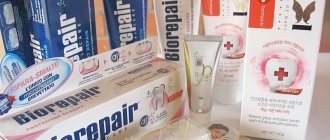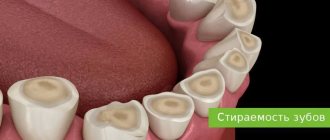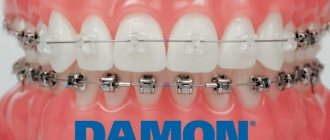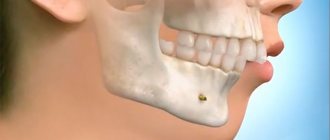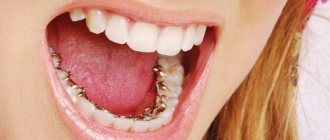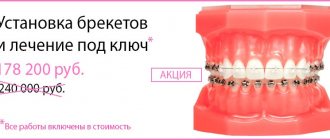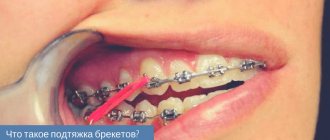Many people believe that braces destroy enamel, promote tooth decay, and cause other dental diseases. Is this really true? Should a person refuse orthodontic treatment if there is a risk of damage to teeth or gums? In this article we will answer these questions.
In this article
- Do braces damage teeth?
- Why do teeth get damaged from braces?
- How to prevent enamel damage when wearing braces
- Hygiene with braces
Braces are complex structures consisting of several parts: screws, locks, arches, etc. As a rule, they are made of metal. If the system is made of another material, such as plastic, ceramic or sapphire, the arc will still be metal. The braces are fixed directly to the tooth enamel using special dental glue and cement. They cannot be removed. A person has to wear the appliance for several months or years, it all depends on the pathology of the bite.
Many patients who have undergone orthodontic treatment report that their teeth deteriorate due to braces. In their opinion, while wearing a dental structure, the enamel becomes thinner, caries often develops, gums become inflamed, etc. According to doctors, such complications occur in medical practice, but braces are not to blame. Let's find out what exactly causes these complications.
Myth 1. Braces damage tooth enamel.
The enamel does not deteriorate directly due to the fixation of braces. Firstly, according to the system installation protocol, a complex of professional hygiene with the removal of dental plaque is first performed. In addition, the place where the bracket is fixed to the tooth is treated with a special disinfecting gel, then the bracket is tightly glued to the tooth. Therefore, bacterial plaque cannot get under it. The enamel around the bracket is the place that is more difficult to clean due to difficult access. If the patient has been selected with the necessary brushes and brushes, taught the correct cleaning technique, and he conscientiously follows the recommendations, and at the same time goes for professional hygiene at least once every 4 months, then there will be no problems with the enamel. We remove the braces and your teeth look exactly the same as they did before treatment. If you take hygiene with braces lightly, then chalky or brown spots of demineralization may appear on the enamel around the structures - areas devoid of minerals, dangerous in terms of the development of caries. We see this quite often in teenagers with poor oral hygiene.
How to prevent enamel damage when wearing braces
To maintain dental health while wearing orthodontic braces, the patient must adhere to a diet and carefully practice good hygiene. First, we’ll tell you how a person with braces should eat.
Immediately after their installation, you can only eat soft or liquid food in order to quickly get used to the design. Subsequently, you should refuse:
- Hard products: nuts, a number of fruits and vegetables, dried fruits, crackers, hard meat, etc. They can damage the arch structure, gums or enamel. Damage to braces will require additional costs. However, this does not mean that you will have to completely exclude carrots, nuts and other foods from your diet - they can be eaten pureed.
- Sticky food: candies and chocolate with nougat, corn flakes, chewing gum, cheeses, etc. The remains of such products stick to the braces and become a source for the spread of bacteria. In addition, most of these foods contain a lot of fast carbohydrates, which feed cariogenic bacteria. Because of this, caries can develop.
- Products with small grains: raspberries, chia, sesame, strawberries, kiwi, etc. The seeds from these products end up in locks, and it is quite difficult to clean them out. The functionality of the braces may be impaired. In addition, microbes will begin to actively multiply in the parts of the staples, which contribute to the occurrence of various diseases.
- Foods and drinks with dyes: coffee, tea, soda, etc. You don’t need to give them up completely, but you will still have to limit their consumption, otherwise the braces will darken first, and then the enamel. In addition, dyes cause plaque and tartar to form faster, which is a favorable environment for the spread of bacteria.
Also, a patient with braces needs to observe the temperature regime while eating. It is not recommended to eat food that is too hot or cold, which can affect the braces and enamel. While wearing braces, it is advisable to eat healthy foods containing vitamins and minerals. They speed up the process of restoring the structure of the tooth surface.
Myth 2. Age affects the ability to be treated with braces.
Many patients are surprised that they can be treated with braces at 30, 40, 50, 60 and 70 years old! And in general at any age.
There are two categories of orthodontic patients:
- The patient is at the stage of jaw growth, peak growth usually occurs at 11-12 years of age.
- The patient is no longer growing - he has a full set of teeth and jaw growth has stopped, most often he is 15-16 years old and older.
In the first case, the orthodontist works with the teeth and jaw, in the other - only with the teeth. At the stage of stopped growth, jaw correction can only be performed by an orthognathic surgeon. But there are no age restrictions for aligning the dentition and correcting the bite.
Causes of complications
The following factors can provoke demineralization of enamel during bite correction with braces:
|
- The use of low-quality adhesive during the installation process.
If the orthodontist applies the adhesive layer unevenly or if there is an insufficient amount of fluoride in its composition, then the protective functions of the film are significantly weakened. At the places where braces are attached, gaps form, allowing access for pathogens to enter. - Pregnancy.
Dentists do not recommend installing braces during pregnancy. The restriction is due to the constant supply of useful microelements by the woman’s body to the child. During this period, fixed braces can trigger the process of appearance of chalky stains on the protective layer of the teeth.
Remember!
Not everyone develops negative manifestations. They can also be facilitated by weakened body defenses. Therefore, during the period of orthodontic correction, it is very important to pay special attention to strengthening the immune system.
Myth 3. You need to come to the orthodontist when all your permanent teeth have erupted.
This myth is often spread by dentists. They say that, despite the problems, there is no need to show the child to the orthodontist now, let all the teeth erupt.
This is an outdated approach. Indeed, there are situations in which it is worth waiting for a complete change in the bite. But there are problems that require urgent treatment, sometimes even at 5-6 years old. These are mainly pronounced bite pathologies - an overdeveloped upper or lower jaw, which is caused by bad habits, and if we wait until all the teeth erupt and jaw growth stops, then surgery will be the only option to solve the problem. There is no need to condemn your child to this from the very beginning.
Sometimes, even in early childhood, the doctor and parents notice that the child swallows incorrectly or has a bad habit of sucking his tongue, finger, or some other object. In this case, it is enough to pay attention to this habit and start fighting it early - either on your own or with the help of a speech therapist with special exercises. There are also orthodontic devices for correcting such habits - for example, a plate with a tongue barrier.
While the child is small, has baby teeth and jaws are still growing, it is often enough to remove the cause of the developing bite pathology. If this is not done in time, this can lead to significant deformities that will be very difficult or impossible to treat without surgery.
There are two stages of jaw growth spurts - at 1.5 years and at 6-7 years. This moment can be used to stimulate jaw growth using devices. If the child wears the removable device well, the treatment will work. But parents’ efforts are also needed, because the child’s compliance with the recommendations must be monitored.
Therefore, it is obvious that it makes sense to visit an orthodontist and, if there are problems, start working on them as early as possible, so as not to miss the moment to give your child a beautiful smile and harmonious facial features.
“Braces are ugly”
Today, braces are a fashion accessory. Many perceive them as an indicator of wealth and a sign that you care about your health. Currently, there is a large selection of brace systems: metal, sapphire, ceramic, etc. If you are not satisfied with the appearance of metal locks, you can choose crystal-transparent sapphire braces or tooth-colored ceramic braces, as well as combined options.
Beautiful braces are real.
And remember that correcting your bite with braces is possible not only in childhood. Adult patients also very often get braces, because it’s never too late to take care of the health and beauty of your smile!
Myth 4. About eighth teeth
There is such a common opinion among orthodontists and dentists that when the eighth teeth, or so-called “wisdom teeth,” erupt, they do not have enough space in the dentition, and they allegedly begin to push the teeth in front, leading to curvature. Also, patients often complain of crowded teeth after the appearance of “eights”, and by the time of treatment these teeth may have already been removed. In fact, no one has scientifically proven the relationship between the eruption of wisdom teeth and the appearance of crowding. Even in people with the rudiments of the eighth teeth already removed in childhood, curvature in the anterior section may appear due to gradual abrasion and, as a result, narrowing of the dentition. In addition, with age, the periodontal ligaments that hold the teeth in the bone tissue weaken, which can also cause a change in their position.
Gum inflammation
During and after orthodontic treatment, the patient begins to notice that while wearing braces, his gums have receded. Inflammation of soft tissues occurs due to poor dental care, lack of vitamins or incorrectly installed orthodontic system. You also need to understand that after tooth extraction there may also be inflammation of the gums.
In rare cases, a complication of wearing braces is gum recession and exposure of tooth roots.
In most cases, the inflammatory process in the gums while wearing braces begins due to poor hygiene. Braces make the cleaning process more difficult, which often leads to plaque deposits and tartar formation. As a result, problems begin, the gums bleed and hurt. The same symptoms can be observed after braces are removed.
A more rare reason is incorrect installation of the orthodontic system or its manufacturing errors. In these cases, braces can injure the gums, after which inflammation begins. If, some time after installing an orthodontic system, you notice that your gums are swollen, pain, and bleeding appear, then it is better to visit an orthodontist. This is necessary to eliminate the possibility of incorrect position of the braces.
A similar situation can be observed after braces are removed for the same reason - weakening of the gums occurs as a result of the accumulation of plaque, which is a breeding ground for various bacteria and pathogenic microorganisms.
It is important to recognize inflammation in the early stages and go to the orthodontist so that the doctor can prescribe treatment. When wearing braces, it is important to regularly brush your teeth twice a day and after every meal, and the use of an irrigator is recommended.
Myth 5. After the plate in childhood, braces are not needed
If a patient had treatment with a plate or partial braces in childhood, this does not always guarantee avoidance of orthodontic treatment in the future. Very often during consultations we hear from parents of teenagers that they previously had treatment with braces, in which case it is quite difficult to explain the need for repeated treatment. You need to understand that orthodontic treatment can be carried out in several stages. The first stage is in childhood with the help of a plate or partial braces, and the second stage is in adolescence, already at the stage of permanent dentition.
Prices for installing braces
| Name | Price |
| Ceramic braces | 40,000 rub. |
| Metal braces | 25,000 rub. |
| Lingual brace system “Incognito” | 300,000 rub. |
| Observation (one visit) | 500 rub. |
| Treatment of dental anomalies (Invisioline) | from 20,000 rub. |
| Treatment of dental anomalies of the 1st degree of complexity | 25,000 rub. |
| Treatment of dental anomalies of the 2nd degree of complexity | 50,000 rub. |
| Treatment of dental anomalies of the 3rd degree of complexity | 75,000 rub. |
| Treatment of dental anomalies of the 4th degree of complexity | 100,000 rub. |
Malocclusion - an aesthetic defect
For most people in adulthood, aesthetic defects become the motivator for installing braces. An incorrect bite spoils your smile and can cause facial asymmetry and the formation of early wrinkles, however, there are also more serious consequences.
Due to uneven dentition, the jaws do not close, resulting in uneven distribution of the load, the mandibular joint is affected, and inflammation of the periodontium and gums occurs. Also, bite pathology provokes premature wear of tooth enamel, frequent caries and its complications.
Bite correction with braces helps not only eliminate aesthetic defects, but also prevent dental diseases that can lead to premature tooth loss.
What after braces?
After achieving the desired result, the braces are removed. But the work on a beautiful smile does not end there. Now you need to “force” the teeth to remain in the same position. This is the task of retainers and aligners. A retainer is a metal wire that is placed on the inside of the front central teeth. It is secured using a special filling material. Serves as a kind of stabilizer and prevents teeth from moving apart.
A mouthguard is a completely transparent lining that fits tightly to the tooth enamel. Made from biopolymer materials. This eliminates the risk of allergic reactions.
Mouth guards are comfortable to wear and invisible to others.
The teeth must get used to the new position, because the body constantly resists and demands that everything be returned to its place. If you neglect to install retainers or aligners, the results from wearing braces for many months can quickly disappear.
